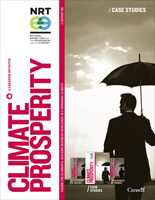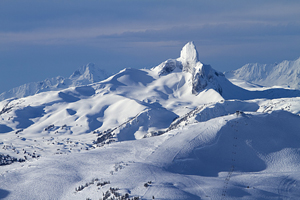Whistler Blackcomb Holdings Inc. – Case Study
FACING THE ELEMENTS: Building Business Resilience in a Changing Climate
|
“What we build today must ensure climate change resilience tomorrow.”– Arthur DeJong, Mountain Planner and Environmental Resource Manager, Whistler Blackcomb |

|
AT A GLANCE // |
Location:Whistler, British Columbia Industry:Arts, entertainment and recreation Employees:3,500 (winter) Revenue (2010):C$224 million Number of visitors each winter:2 million |
Key adaptation
|
Adaptation
|
Business BenefitsInvestments maximized by building resilience into infrastructure at the planning stage Improved communication about climate change risk to investors and the media |
Business ChallengesSignificant range of projected changes in climate |
COMPANY OVERVIEW //
WHISTLER, BRITISH COLUMBIA
www.whistlerblackcomb.com

Photo: Whistler Blackcomb
Today the company is responsible for managing close to 32 km2 of ski area on two neighbouring mountains connected by a pedestrian village and a mechanical gondola. Vertical elevation on both mountains approaches 2330 m. Overall, the resort includes three glaciers, twelve snow-filled mountain valleys, over 200 trails and a system of 37 mechanical lifts.
Recently Whistler Blackcomb made headlines as the official alpine skiing venue for the 2010 Olympic and Paralympic Winter Games.
The resort’s new “Peak 2 Peak” gondola links Whistler and Blackcomb mountain tops. At 436 metres above the valley floor, and with an unsupported span of more than 3 kilometres, this feat of engineering has broken several world records for height and length.
Whistler Blackcomb is both symbolically and financially important for the Canadian tourism industry. The resort generates considerable revenues, the majority of which are presently generated during winter.
SKI RESORTS IN A CHANGING CLIMATE
Winter sport resorts are directly vulnerable to climate change, as the quality of skiing and snowboarding guest experiences are dependent on snowfall. In recent decades, rising temperatures have resulted in decreased snow accumulation, particularly at low elevations, and a higher ratio of rain to snow.54 In future, a reduction in winter snowpack and earlier snowmelt is projected for mountainous areas.
Glacier retreat on Whistler Blackcomb’s tenure area is very evident. Although glacier loss will not affect revenues (the resort’s summer glacier ski operation is very small), the glaciers are certainly a key indicator for climate warming. Glaciers are often considered “nature’s thermometer”, such is their sensitivity to climate change. Interestingly, the glaciers at Whistler Blackcomb are not reducing in size because of reduced snowpack (the last two decades have seen more snow at glacier elevations in the area), but rather the increased summer heat is primarily causing the retreat.
Wildfires are another concern at Whistler Blackcomb. In 2009, wildfires necessitated evacuations from the resort area. Rising temperatures and higher risk of drought are likely to exacerbate wildfire risk in future.
ADAPTATION AS PART OF A COMPREHENSIVE CLIMATE CHANGE MANAGEMENT STRATEGY
In its 2008-2009 Sustainability Report, Whistler Blackcomb highlighted the resort’s historical dependence on a stable climate, and acknowledged that it is on the frontlines of climate change impacts. Taking into account the projected impacts on mountain ecosystems and the knock-on financial consequences, the company has since recognized climate change as an umbrella issue that is integral to all elements of its environmental program.
The company’s approach to climate risk management is described as flexible and iterative. Exchange with other ski resorts and associations is encouraged, and assessments and management measures are re-assessed regularly.
Whistler Blackcomb has developed a seven-step strategic framework around three pillars: assessment, action and advocacy (see Figure 4). Four of these steps include consideration of climate change risks and adaptation:

Step 1 // What are the financial implications of climate change (negative, positive, neutral )?
At the assessment phase, Whistler Blackcomb took stock of likely climate change impacts on the resort, and appraised the potential financial consequences. The resort used figures from the Intergovernmental Panel on Climate Change (IPCC) that projects a 120m snowline rise with every degree Celsius increase. Using a scenario-based approach, the assessment concluded that the ski resort could withstand the financial consequences of an increase in average global temperature between 2 and 3.5°C this century compared with 1980-1999. This is partly due to the significant adaptive capacity of the resort. Whistler Blackcomb has over a mile of vertical rise with the majority of its terrain at higher elevations. Its physical geography is like an ice cream cone – wide at the top and narrow at the bottom – which gives the resort the option of moving ski areas upslope where snow is more abundant, a comparative advantage that many lower-altitude ski areas do not have.
Step 4 // Adaptation
Whistler Blackcomb has already started to plan and implement climate change adaptation measures. In recent years, the company has doubled its snow making capacity to maintain its ski area extent. To improve ski run conditions in a warmer climate, the company is also investing in a summer grooming program, removing rocks and smoothing out run surfaces with earth moving equipment, and cultivating a thick grass root cover. These measures are known to optimize winter snow cover. During the winter, Whistler Blackcomb manages snow cover on runs by snowfencing, which consists of installing fences to force snow to accumulate in desired areas, such as ski runs. The company also uses snow groomers to collect and distribute snow. Finally, the company has developed plans to increase upslope lift capacity and develop lift interconnections at high altitudes. In a changing climate these investments will allow Whistler Blackcomb to transport visitors higher up the mountains to take advantage of high elevation snowpack.
Step 6 // Risk diversification
In recent years, Whistler Blackcomb has developed a ‘buffet’ of recreational activities for the off-peak months of May through November, including nature walks, hiking trails and mountain biking routes. Though winter visitors tend to spend more money on average, the company is working hard to achieve a ‘four-season’ growth model whereby revenues are less dependent on skiing and snowboarding.
These new nature-based activities take advantage of the resort’s natural beauty and contribute to the achievement of the company’s low-energy, low-waste and conservation objectives.
Step 7 // Inspire others through your actions and education programs
Whistler Blackcomb has made a concerted effort to communicate the results of its climate change work. For example, the company presented its seven-step climate change strategy to the 2007 UN World Tourism Climate Change Conference in Davos. The company also aims to inspire change by being a ‘pro-active educator’ on climate change impacts. To this end, the resort offers glacier visits so that guests can observe firsthand how ice has receded in recent years.
BENEFITS AND/OR CHALLENGES
Thanks to its informed approach to climate change adaptation, the company is maximizing current investment in infrastructure by ensuring that new and upgraded lifts reach snow areas at higher altitudes. This avoids the need for costly early replacement as the climate changes.
Furthermore, because the company understands its vulnerability to climate change and the adaptation solutions that are available, it is better prepared to respond to media or investor queries about the future resilience of the resort.
NEXT STEPS
Climate change adaptation is fully recognised as a business and environmental necessity by Whistler Blackcomb. However, the company wants to avoid over-adapting, given that some climate risk management measures (e.g. snow-making machines) are costly. For this reason the resort is concentrating on increasing energy efficiency as part of mitigation efforts to avoid unmanageable changes in climate, diversifying guest experiences, and other short-term actions which are expected to reduce costs or create value for the company.
PERSPECTIVES ON GOVERNMENT ROLES
Government has a leading role to play to help ski resorts adapt to a warmer world by reviewing land use policy and legislation and considering innovative land transfer mechanisms. With increasing temperatures, ski areas such as Whistler Blackcomb will need to move upslope to reach higher snowpack. At present, this is impossible since the province owns the land at higher altitudes. Land transfer mechanisms or flexible land use legislation could help to maintain the size of ski areas by facilitating exchanges between lowland mountain areas owned by ski resorts and highland mountain areas owned by the Crown.
Government should also continue to support climate monitoring and research efforts to understand changing climate patterns at the local level.
[54] Walker and Sydneysmith 2008








































